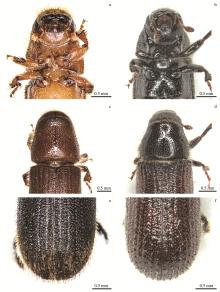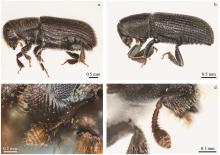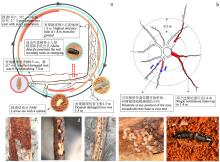

林业科学 ›› 2021, Vol. 57 ›› Issue (5): 140-150.doi: 10.11707/j.1001-7488.20210513
任利利1,陶静1,武海卫2,宗世祥1,王传珍3,华德4,石娟1,刘漪舟1,骆有庆1,*
收稿日期:2021-03-19
出版日期:2021-05-25
发布日期:2021-07-09
通讯作者:
骆有庆
基金资助:Lili Ren1,Jing Tao1,Haiwei Wu2,Shixiang Zong1,Chuanzhen Wang3,De Hua4,Juan Shi1,Yizhou Liu1,Youqing Luo1,*
Received:2021-03-19
Online:2021-05-25
Published:2021-07-09
Contact:
Youqing Luo
摘要:
目的: 明确国际重大林业检疫性害虫长林小蠹在我国的入侵、定殖并严重危害,研究其形态特征、分子鉴定和危害特点,为该虫的监测及防控提供理论基础。方法: 对采自山东省烟台市牟平区日本黑松根部的小蠹幼虫、蛹及成虫进行形态学观察、拍照和比对。提取其基因组DNA,利用小蠹亚科通用引物扩增核糖体大亚基(28S)和线粒体细胞色素氧化酶亚基Ⅰ(COⅠ)序列进行测序,在NCBI数据库中进行序列比对。初步调查长林小蠹的危害特点。结果: 成虫形态特征完全符合长林小蠹的描述;基于28S基因序列构建系统发育树(ML树)显示,山东烟台小蠹样本与厦门口岸截获来自于澳大利亚进口辐射松原木的样本序列,以及德国样本序列和美国样本序列聚成一支,置信度为100%;样本COⅠ序列单倍型与海关截获的来源于新西兰辐射松上长林小蠹样本单倍型相同,明确外来入侵种长林小蠹已在我国定殖。该虫严重危害寄主树木根部。结论: 首次发现重大入侵害虫长林小蠹在我国的定殖与严重危害,已明确主要形态鉴别特征及初步侵害特性;基因序列分析结果可用于开发快速鉴定技术和溯源分析,同时为虫害检测与监测提供理论依据和技术支撑。
中图分类号:
任利利,陶静,武海卫,宗世祥,王传珍,华德,石娟,刘漪舟,骆有庆. 重大害虫长林小蠹入侵我国的首次发现与侵染特征[J]. 林业科学, 2021, 57(5): 140-150.
Lili Ren,Jing Tao,Haiwei Wu,Shixiang Zong,Chuanzhen Wang,De Hua,Juan Shi,Yizhou Liu,Youqing Luo. The First Discovery and Infective Characteristics of A Major Invasive Pest Hylurgus ligniperda (Coleoptera: Scolytidae) in China[J]. Scientia Silvae Sinicae, 2021, 57(5): 140-150.
表2
相关建树序列信息"
| NCBI登录号 NCBI accession No. | 物种名称 Species | 采集地 Location |
| JX263769 | 长林小蠹 Hylurgus ligniperda | 新西兰奥克兰 Auckland, New Zealand |
| MH005064 | 长林小蠹 Hylurgus ligniperda | 厦门口岸截获来自于澳大利亚辐射松 Xiamen port intercepted from the Australian Radiata Pine |
| KJ531125 | 长林小蠹 Hylurgus ligniperda | 德国Germany |
| JX263770 | 米林小蠹 Hylurgus micklitzi | 西班牙Spain |
| HQ883927 | Hylastes opacus | 瑞典Sweden |
| KJ531123 | Hylastes attenuates | 德国Germany |
| AF308364 | Hylurgops rugipennis | 美国USA |
| JX263728 | Hylurgops glabratus | 挪威Norway |
| AF308365 | Hylesinus varius | 美国USA |
| JX263725 | Hylesinus toranio | 英格兰England |
| HQ883592 | 纵坑切梢小蠹 Tomicus piniperda | 挪威Norway |
| AF308386 | 黑脂大小蠹 Dendroctonus terebrans | 美国USA |
| HQ883591 | 云杉大小蠹 Dendroctonus micans | 爱沙尼亚Estonia |
| AF308385 | 山松大小蠹 Dendroctonus ponderosae | 美国USA |
| AF308380 | 间大小蠹 Dendroctonus adjunctus | 美国USA |
| FJ867678 | 黄杉大小蠹 Dendroctonus pseudotsugae | 美国USA |
| MH997403 | 南方松大小蠹 Dendroctonus frontalis | 墨西哥Mexico |
| JX263669 | Bothrosternus foveatus | 哥斯达黎加Costa Rica |

图2
长林小蠹与切梢小蠹属形态特征的对比 a. 前足基节窝相连(长林小蠹)Procoxae contiguous (H. ligniperda); b. 前足基节窝微分离(横坑切梢小蠹)Procoxae moderately separated (Tomicus minor); c. 前胸背板较狭长(长林小蠹)Pronotum more slender (H. ligniperda); d. 前胸背板较粗壮(横坑切梢小蠹)Pronotum stouter (T. minor); e. 鞘翅沟间部毛多列(长林小蠹)Erect interstrial setae abundant, confused (H. ligniperda); f. 鞘翅沟间部毛单列(横坑切梢小蠹)Erect interstrial setae in uniseriate rows (T. minor)."


图4
长林小蠹与根小蠹属形态特征的对比 a. 鞘翅基缘隆起,体表被长毛(长林小蠹)Crenulations on elytral bases usually well developed, body surface setae usually hairlike (H. ligniperda); b. 鞘翅基缘不隆起,体表被短刚毛或鳞片(黑根小蠹)Crenulations on elytral bases usually poorly developed,body surface setae scalelike or bristle (Hylastes parallelus); c. 触角鞭节6节(长林小蠹)Antennal funicle 6 segmented (H. ligniperda); d. 触角鞭节7节(黑根小蠹)Antennal funicle 7 segmented (H. parallelus)."


图9
长林小蠹危害特征初步观察 a. 长林小蠹危害特点示意Schematic diagram of the damaging characteristics of H. ligniperda; b. 长林小蠹危害根部特点示意Schematic diagram of the damaging characteristics of H. ligniperda to roots; c. 危害后根皮下的虫粪The beetle frass under the root bark; d. 成虫聚集钻蛀坑道Adults gathering and boring the tunnel; e. 坑道内蛹室Pupal chambers in the tunnel;f. 聚集危害的幼虫Larvae gathering and damaging; g. 坑道内成虫交配Mating of adults in the tunnel."

| 国家质量监督检验检疫总局. [2021-03-10]. 中华人民共和国进境植物检疫性有害生物名录. (2017-06-14). http://www.aqsiq.gov.cn/xxgk_13386/zvfg/gfxwj/dzwjy/201706/P020170614493504815080.doc. | |
| State Administration of Quality Supervision, Inspection and Quarantine. [2021-03-10]. List of plant quarantine pests in the People's Republic of China. (2017-06-14). http://www.aqsiq.gov.cn/xxgk_13386/zvfg/gfxwj/dzwjy/201706/P020170614493504815080.doc[in Chinese]. | |
| 黄蓬英, 方志鹏, 林玲玲, 等. 南部松齿小蠹和长林小蠹幼虫分子鉴定. 植物检疫, 2018, 32 (4): 43- 47. | |
| Huang P Y , Fang Z P , Lin L L , et al. Molecular identification for larvae of Ips grandicollis (Eichhoff) and Hylurgus ligniperda Fabricius. Plant Quarantine, 2018, 32 (4): 43- 47. | |
| 梁振, 张俊华, 杨定, 等. 2005~2015年我国口岸截获外来昆虫概况. 植物检疫, 2017, 31 (6): 64- 68. | |
| Liang Z , Zhang J H , Yang D , et al. Overview of alien insects intercepted at China ports from 2005 to 2015. Plant Quarantine, 2017, 31 (6): 64- 68. | |
|
王仿, 陈寿铃, 周卫川. 长林小蠹的识别鉴定. 植物检疫, 2006, 20 (1): 30- 31.
doi: 10.3969/j.issn.1005-2755.2006.01.012 |
|
|
Wang F , Chen S L , Zhou W C . Identification of Hylurgus ligniperda Fabricius. Plant Quarantine, 2006, 20 (1): 30- 31.
doi: 10.3969/j.issn.1005-2755.2006.01.012 |
|
| 魏厚德, 邵沛泽. 对一批带有长林小蠹的进口木材实施检疫的作法. 植物检疫, 1991, 5 (3): 199- 200. | |
| Wei H D , Shao P Z . Implementation of quarantine practices on a batch of imported timber with Hylurgus ligniperda Fabricius. Plant Quarantine, 1991, 5 (3): 199- 200. | |
|
杨晓军, 安榆林. 进口辐射松原木截获长林小蠹的检疫鉴定. 植物检疫, 2002, 16 (5): 288- 289.
doi: 10.3969/j.issn.1005-2755.2002.05.013 |
|
|
Yang X J , An Y L . Quarantine and identification of Hylurgus ligniperda Fabricius intercepted from imported Radiata Pine logs. Plant Quarantine, 2002, 16 (5): 288- 289.
doi: 10.3969/j.issn.1005-2755.2002.05.013 |
|
| 袁克, 杜国兴. 进口木材小蠹虫鉴定图谱. 上海: 上海科学技术出版社, 2007. | |
| Yuan K , Du G X . Identification atlas of bark beetles in imported wood. Shanghai: Shanghai Science and Technology Press, 2007. | |
| 中华人民共和国国家质量监督检验检疫总局. 中华人民共和国出入境检验检疫行业标准, 长林小蠹检疫鉴定方法(SN/T 1722-2006). 北京: 中国标准出版社, 2006. | |
| The General Administration of Quality Supervision, Inspection and Quarantine of the People's Republic of China . The People's Republic of China Entry-Exit Inspection and Quarantine Industry Standard. Methods for quarantine and identification of Hylurgus ligniperda Fabricius (SN/T 1722-2006). Beijing: China Standards Press, 2006. | |
| Alonso-Zarazaga M A , Barrios H , Borovec R , et al. Cooperative catalogue of palaearctic Coleoptera Curculionoidea. Zaragozac(Spain): Monografías electrónicas SEA. vol.8, 2017, 515 | |
| Ambrogioni L , Marinari P A . Description of Bursaphelenchus tusciae sp. n. from Pinus pinea in Italy. Nematologia Mediterranea, 1998, 26 (2): 243- 254. | |
| Balachowsky A . Coléoptères Scolytides. Faune de France 50. Paris: Libraire de la Faculté des Sciences, 1949. | |
| Bright D E , Skidmore R E . Catalog of Scolytidae and Platypodidae (Coleoptera), Supplement 1(1990-1994). Ottawa: NRC Research Press, 1997. | |
| Browne F G . Pests and diseases of forest plantation trees: An annotated list of the principal species occurring in the British Commonwealth. Oxford: Clarendon Press, 1968. | |
| CABI. Hylurgus ligniperda(red-haired pine bark beetle)[2021-03-10]. https://www.cabi.org/isc/datasheet/27364. | |
| Carletti B . Bursaphelenchus species with their natural vectors in Italy: Distribution and essential diagnostic features. Redia, 2008, 91, 111- 117. | |
| Carletti B , Irdani T , Ambrogioni L , et al. New occurrences of Bursaphelenchus species (Nematoda Parasitaphelenchidae) phoretic associate of bark beetles in Italy. Redia, 2008, 91, 67- 71. | |
| Ciesla W M . Pine bark beetles: A new pest management challenge for Chilean forests. Journal of Forestry, 1988, 86 (12): 27- 31. | |
|
Davydenko K , Vasaitis R , Meshkova V , et al. Fungi associated with the red-haired bark beetle, Hylurgus ligniperda (Coleoptera: Curculionidae) in the forest-steppe zone in eastern Ukraine. European Journal of Entomology, 2014, 111 (4): 561.
doi: 10.14411/eje.2014.070 |
|
| Eglitis A. 2001. Exotic Forest Pest Information System for North America: Hylurgus ligniperda. North American Forestry Commission. http://spfnic.fs.fed.us/exfor/data/pestreports.cfm?pestidval=59&langdisplay=english. | |
|
El-Khoury Y , Binazzi F , Nemer N , et al. Bark beetles (Coleoptera Curculionidae Scolytinae) associated with Pinus pinea in Lebanon: New records with remarks on their ecology, distribution and potential threat for forest stands. Redia, 2019, 102, 121- 128.
doi: 10.19263/REDIA-102.19.18 |
|
| Fabre J P , Carle P . Contribution to the biological study of Hylurgus ligniperda F. (Coleoptera Scolytidae) biology in the south eastern part of France. In Annales des Sciences Forestieres, 1974, 32 (1): 55- 71. | |
|
Hoang D T , Chernomor O , Von Haeseler A , et al. UFBoot2:Improving the ultrafast bootstrap approximation. Molecular Biology and Evolution, 2018, 35 (2): 518- 522.
doi: 10.1093/molbev/msx281 |
|
| International Plant Protection Commission. International phytosanitary portal. [2021-03-10]. https://www.ippc.int/IPP/En/default.jsp. | |
| Jankowiak R , Bilański P . Ophiostomatoid fungi associated with root-feeding bark beetles on Scots pine in Poland. Forest Pathology, 2013, 43 (5): 422- 428. | |
|
Jordal B H , Sequeira A S , Cognato A I . The age and phylogeny of wood boring weevils and the origin of subsociality. Molecular Phylogenetics and Evolution, 2011, 59 (3): 708- 724.
doi: 10.1016/j.ympev.2011.03.016 |
|
|
Kalyaanamoorthy S , Minh B Q , Wong T K , et al. ModelFinder: Fast model selection for accurate phylogenetic estimates. Nature Methods, 2017, 14 (6): 587- 589.
doi: 10.1038/nmeth.4285 |
|
|
Katoh K , Standley D M . MAFFT multiple sequence alignment software version 7:Improvements in performance and usability. Molecular Biology and Evolution, 2013, 30 (4): 772- 780.
doi: 10.1093/molbev/mst010 |
|
| Kim S , Harrington T C , Lee J C , et al. Leptographium tereforme sp. nov. and other Ophiostomatales isolated from the root-feeding bark beetle Hylurgus ligniperda in California. Mycologia, 2011, 103 (1): 152- 163. | |
|
Librado P , Rozas J . DnaSP v5:A software for comprehensive analysis of DNA polymorphism data. Bioinformatics, 2009, 25 (11): 1451- 1452.
doi: 10.1093/bioinformatics/btp187 |
|
| Liu D, Bohne M J, Lee J C, et al. 2007. New introduction in California: The redhaired pine bark beetle, Hylurgus ligniperda Fabricius. Pest Alert R5-PR-07. Berkeley, CA: US Department of Agriculture, Forest Service, Pacific Southwest Research Station. | |
| Mausel D L , Gara R I , Lanfranco D , et al. The introduced bark beetles Hylurgus ligniperda and Hylastes ater (Coleoptera: Scolytidae) in Chile: Seasonal flight and effect of Pinus radiata log placement on colonization. Canadian Journal of Forest Research, 2006, 37 (1): 156- 169. | |
|
McKenna D D , Sequeira A S , Marvaldi A E , et al. Temporal lags and overlap in the diversification of weevils and flowering plants. Proceedings of the National Academy of Sciences, 2009, 106 (17): 7083- 7088.
doi: 10.1073/pnas.0810618106 |
|
|
Mejr M , Fonseca L , Cardoso J M S , et al. Bursaphelenchus tusciae in Tunisia associated with Hylurgus ligniperda. Forest Pathology, 2016, 46 (6): 663- 665.
doi: 10.1111/efp.12297 |
|
|
Nguyen L T , Schmidt H A , Von Haeseler A , et al. IQ-TREE: A fast and effective stochastic algorithm for estimating maximum-likelihood phylogenies. Molecular Biology and Evolution, 2015, 32 (1): 268- 274.
doi: 10.1093/molbev/msu300 |
|
| Park S , Jong C J , Taeman H . A new species and five newly recorded species of Scolytinae (Coloptera: Curculionidae) from Korea. Entomological Research Bulletin, 2017, 33 (2): 131- 137. | |
|
Penas A C , Bravo M A , Naves P , et al. Species of Bursaphelenchus Fuchs, 1937(Nematoda: Parasitaphelenchidae) and other nematode genera associated with insects from Pinus pinaster in Portugal. Annals of Applied Biology, 2006, 148 (2): 121- 131.
doi: 10.1111/j.1744-7348.2006.00042.x |
|
|
Penas A C , Correia P , Bravo M A , et al. Species of Bursaphelenchus Fuchs, 1937(Nematoda: Parasitaphelenchidae) associated with maritime pine in Portugal. Nematology, 2004, 6 (3): 437- 453.
doi: 10.1163/1568541042360573 |
|
|
Pistone D , Gohli J , Jordal B H . Molecular phylogeny of bark and ambrosia beetles (Curculionidae: Scolytinae) based on 18 molecular markers. Systematic Entomology, 2018, 43 (2): 387- 406.
doi: 10.1111/syen.12281 |
|
|
Pistone D , Mugu S , Jordal B H . Genomic mining of phylogenetically informative nuclear markers in bark and ambrosia beetles. PloS One, 2016, 11 (9): e0163529.
doi: 10.1371/journal.pone.0163529 |
|
|
Ray S D , Thwaites J M , Farrell R L . Survey of Ophiostomataceae associated with Hylurgus ligniperda (Curculionidae: Scolytinae) in New Zealand. New Zealand Entomologist, 2006, 29 (1): 21- 26.
doi: 10.1080/00779962.2006.9722137 |
|
| Schedl K E . Neotropische Scolytoidea Ⅷ, 238. Betrag zur Morphologie und Systematik der Scolytoidea. Entomologische Arbeiten aus dem Museum G. Frey Tutzing Bei Muenchen, 1966, 17, 74- 128. | |
| Schedl K E . Scolytoidea (Coleoptera), mainly from South Africa. Annals of the Transvaal Museum, 1982, 33 (15): 277- 286. | |
|
Sequeira A S , Normark B B , Farrell B D . Evolutionary assembly of the conifer fauna: Distinguishing ancient from recent associations in bark beetles. Proceedings of the Royal Society of London. Series B: Biological Sciences, 2000, 267 (1460): 2359- 2366.
doi: 10.1098/rspb.2000.1292 |
|
|
Susoy V , Herrmann M . Preferential host switching and codivergence shaped radiation of bark beetle symbionts, nematodes of Micoletzkya (Nematoda: Diplogastridae). Journal of Evolutionary Biology, 2014, 27 (5): 889- 898.
doi: 10.1111/jeb.12367 |
|
| Swan D C . The bark beetle-Hylastes ater Payk. (Coleoptera: Scolytidae) attacking pines in South Australia. Journal of Agriculture, 1942, 12, 86- 90. | |
| Torrini G , Paoli F , Mazza G , et al. First detection of Bursaphelenchus abietinus and B. áandrassyi in Italy. Forest Pathology, 2020, 50 (5): e12627. | |
| Wood S L . A catalog of Scolytidae and Platypodidae (Coleoptera), Part 2:Taxonomic index. Great Basin Naturalist Memoirs, 1992, 13, 1- 1553. | |
| Wood S L . A reclassification of the genera of Scolytidae (Coleoptera). Great Basin Naturalist Memoirs, 1989, 10 (1): 39- 41. | |
| Wood S L . New synonymy and new species of bark beetles (Coleoptera: Scolytidae). Great Basin Naturalist, 1985, 45 (2): 266- 275. | |
|
Zhang D , Gao F , Jakovlić I , et al. PhyloSuite: An integrated and scalable desktop platform for streamlined molecular sequence data management and evolutionary phylogenetics studies. Molecular Ecology Resources, 2020, 20 (1): 348- 355.
doi: 10.1111/1755-0998.13096 |
| [1] | 万琼莲, 王连春, 王泉, 许杏萍, 苏帆, 赵静, 蔡红. 羽脉山黄麻丛枝植原体的分子鉴定及病害调查[J]. 林业科学, 2021, 57(5): 195-201. |
| [2] | 彭瀚,张守科,耿显胜,方林鑫,张威,舒金平,王浩杰. 幼虫取食不同寄主树种的云斑白条天牛成虫种群分化[J]. 林业科学, 2020, 56(7): 91-103. |
| [3] | 高磊,王建国,王章训,李猷,鞠瑞亭. 危险性害虫枫香刺小蠹的形态特征及发生现状[J]. 林业科学, 2020, 56(3): 193-198. |
| [4] | 邓磊,朱春云,于世川,祁银燕,张文辉,杜盛,关晋宏. 祁连山青海云杉中龄林混交度对细根形态特征的影响[J]. 林业科学, 2020, 56(1): 191-200. |
| [5] | 熊佳新,姜宏健,嵇保中,刘曙雯,王怡. 黑胸散白蚁的替代生殖蚁分化[J]. 林业科学, 2019, 55(10): 38-47. |
| [6] | 曹丹丹, 魏建荣, 王伟超, 王丽平, 赵正萍, 刘曙雯, 嵇保中. 松材线虫病死木皮下的南京隐翅虫(鞘翅目:隐翅虫科)[J]. 林业科学, 2019, 55(1): 157-162. |
| [7] | 唐晓琴, 臧建成, 卢杰. 川滇高山栎朱颈褐锦斑蛾(鳞翅目:斑蛾科)生物学特性[J]. 林业科学, 2017, 53(6): 175-180. |
| [8] | 汪少妃, 唐真正, 袁毅, 刘建强, 朱麟. 刺桐姬小蜂虫瘿发育及其结构[J]. 林业科学, 2015, 51(1): 165-170. |
| [9] | 刘群, 常虹, 陈娟, 郝德君. 分月扇舟蛾与仁扇舟蛾的形态学和生物学区别及其进化关系[J]. 林业科学, 2014, 50(1): 97-102. |
| [10] | 梁小妮, 徐程扬, 龚岚, 刘瑜, 齐秀慧. 配置模式和树种组成对北京典型城市森林树木细根形态的影响[J]. 林业科学, 2013, 49(9): 94-101. |
| [11] | 刘淑明, 孙佳乾, 邓振义, 魏典典, 张刚, 孙丙寅. 干旱胁迫对花椒不同品种根系生长及水分利用的影响[J]. 林业科学, 2013, 49(12): 30-35. |
| [12] | 姜嫄;张翌楠;马玲;王慧;胡礼禹;韩杰. 大麦虫成虫活体的雌雄鉴别[J]. 林业科学, 2012, 48(6): 175-177. |
| [13] | 李霞;张真;曹鹏;王鸿斌;韩平定. 切梢小蠹属昆虫分类鉴定方法[J]. 林业科学, 2012, 48(2): 110-116. |
| [14] | 樊永军;闫伟;王黎元. 贺兰山地区青海云杉外生菌根的形态类型及分子鉴定[J]. 林业科学, 2011, 47(6): 108-113. |
| [15] | 商靖;刘雪峰;阿地力·沙塔尔;潘存德;赵震宇;马红霞. 核桃基腐病的病原鉴定[J]. 林业科学, 2010, 46(12): 97-100. |
| 阅读次数 | ||||||
|
全文 |
|
|||||
|
摘要 |
|
|||||